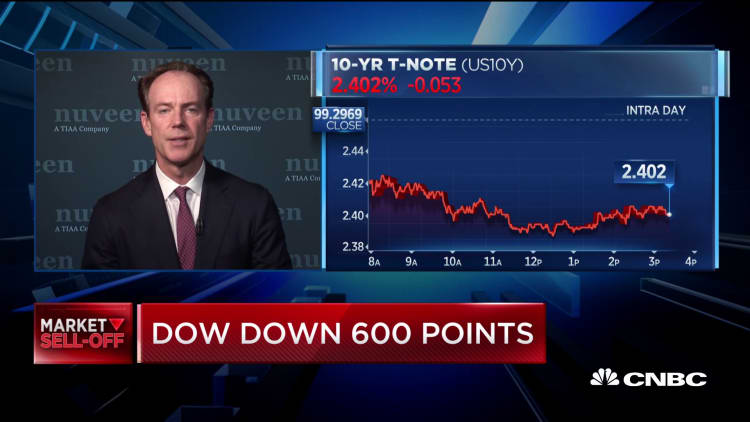Recent market volatility is shining a spotlight on equity funds, but make sure you don't overlook the risks hiding in the "stable" part of your 401(k).
Generally, investors think of bonds as a safe corner of their portfolio, offsetting the day-to-day dramatic movements you might see in stocks.
"The perception is that bonds aren't as risky as stocks," said David Weinstock, a certified financial planner and principal at Mazars USA Wealth Advisors.
"Generally, bonds are less volatile than stocks, but there are anomalies," he said.
Even the bond funds in your retirement plan aren't necessarily safe havens; they also come with risks.

For example, the Financial Industry Regulatory Authority, a self-regulatory organization that oversees brokerage firms, alleged that AXA Advisors misrepresented five of the bond funds in some of its group annuity contracts from September 2010 through November 2015.
The company had said these bond funds were "investment grade" — meaning that they had higher credit quality — when, in reality, they were substantially invested in high-yield or junk bonds, FINRA claimed.
FINRA assessed a $600,000 fine, and ordered AXA to pay $172,000 in restitution to affected 401(k) plan participants.
The company neither admitted nor denied the charges.
"We remain committed to transparency and accuracy in all communications and we regret this occurred," an AXA spokesman said via email. "We are pleased to have resolved this matter and are providing remediation to those who may have been adversely impacted."
Here's what you should know about the bond funds on the menu in your 401(k) plan.
Two major risks

When it comes to investing in fixed income, there are two primary areas of risk: long duration and low credit quality, said David Blanchett, head of retirement research at Morningstar Investment Management.
Bonds with long durations are more sensitive to changes in interest rates, versus short-term bonds. When rates rise, the prices of longer-dated bonds goes down more dramatically.
Meanwhile, credit quality is a reflection of the financial health of the entity issuing the bond. Investment grade bonds have a credit-rating agency rating of BBB- or better on the Standard & Poor's and Fitch Ratings scales, or Baa3 from Moody's.
Bonds with ratings below those levels are riskier and are considered "high-yield" or "junk."
More from Personal Finance:
Best and worst cities for meeting your savings goals
Those credit scores you see may not be what lenders use
Congress moves to allow student loan borrowers to file for bankruptcy
In 2017, 19% of Vanguard's defined contribution plans offer high-yield bond funds, according to the company's How America Saves report.
"High yield has equity-like volatility," said Blanchett. "They might say, 'Oh, this fixed income fund has great returns,' but it isn't safe when the markets perform poorly."
The vast majority of plans tend to offer low duration, high-quality fixed income investments, he said.
Being an educated investor
When it's time to decide how to invest your 401(k) funds, take stock of what's available in your plan's menu and be sure to take risk responsibly.
Here are a few points to consider:
• Get engaged: Think about reaching out to your employer's human resources contact to get a sense of how the funds were selected.
"That's as simple as asking them for the process used to evaluate the funds and how often this happens," said Aaron Pottichen, senior vice president of Alliant Retirement Consulting in Austin, Texas.
Employers have different approaches toward their fund menus, but they typically offer a default investment — such as a target-date fund — along with a number of standalone funds.
On average, plans offer 18 funds for their employees to invest in, according to Vanguard.
• Get educated: Read up on the funds available in your plan, and don't neglect the bond side of the menu. Each fund has its own risk characteristics.
"You have to know enough to understand that one bond isn't the same as another," said Weinstock. "Emerging market debt is very different from a short-term bond fund."
It also helps to find out whether there are other fixed income options available in your plan.
For instance, in addition to bond funds, a 401(k) your plan might offer what's known as a stable value fund. These are similar to money market funds.
Stable value funds are essentially a portfolio of bonds with an "insurance wrapper." They aim to preserve your capital and offer a credited rate of interest. The insurance element of the fund is what shields plan participants from the harmful effects of rising interest rates.
Member companies of the Stable Value Investment Association accounted for $835.3 billion in stable value assets as of the end of 2018, according to the SVIA.
The average annual crediting rate for these funds was 2.57%, as of the end of last year, the SVIA found.
• Know when you're in over your head: There's a time and a place for riskier bonds, and if you're not sure how to make that call, then leave it to the pros.
If you're uncomfortable with selecting the exact allocations for your 401(k) savings, consider going with a target-date fund or with a managed account option, if it's available.
"Understand what you're actually buying," said Blanchett. "If you don't know what a high-yield bond is, then you should be in your plan's default investment."
This article has been updated to include comments from AXA.


